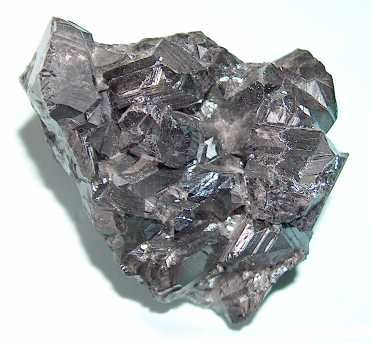|
Kynal
Kynal was a brand name for a series of aluminium alloys developed and originally produced by the British chemical manufacturer Imperial Chemical Industries (ICI). The name was derived from Kynoch, an existing ICI trademark for ammunition, and aluminium. It was largely used as substitute for Alclad, a popular corrosion-resistant aluminium alloy. ICI produced Kynal in quantity at a facility in Waunarlwydd, outside Swansea. The material was extensively used by the British aviation industry during the Second World War, being recognised as a strategic resource. Numerous variations upon the material were devised by ICI around this time. During the 1950s, British Railways became a key consumer of Kynal, using the material on numerous members of its new fleet of diesel traction, including the first generation diesel multiple units (DMUs). By the twenty-first century, the material was largely considered to be obsolete, while the Waunarlwydd chemical works was permanently closed during th ... [...More Info...] [...Related Items...] OR: [Wikipedia] [Google] [Baidu] |
Alclad
Alclad is a corrosion-resistant aluminium sheet formed from high-purity aluminium surface layers metallurgically bonded (rolled onto) to high-strength aluminium alloy core material. It has a melting point of about 500 degrees celsius, or 932 degrees Fahrenheit. Alclad is a trademark of Alcoa but the term is also used generically. Since the late 1920s, Alclad has been produced as an aviation-grade material, being first used by the sector in the construction of the ZMC-2 airship. The material has significantly more resistance to corrosion than most aluminium-based alloys, for only a modest increase in weight, making Alclad attractive for building various elements of aircraft, such as the fuselage, structural members, skin, and cowling. Accordingly, it became a relatively popular material for aircraft manufacturing. Details The material was described in NACA-TN-259 of August 1927, as "a new corrosion resistant aluminium product which is markedly superior to the present strong alloy ... [...More Info...] [...Related Items...] OR: [Wikipedia] [Google] [Baidu] |
Waunarlwydd
Waunarlwydd ( en, The Lord's Meadow – ''arlwydd'' is a local variant of ''arglwydd'') is a village and Community (Wales), community in Swansea, Wales, within the newly formed Waunarlwydd ward in 2021. Wendy Lewis Labour is the first elected councillor for the newly created ward which she comfortably won in the 2022 local elections. In 2022 Waunarlwydd became a community. Transport Buses are provided by First Cymru: these are the 15 or 16 Swansea - Waunarlwydd and Swansea - Gorseinon. The main road in and out of the village is the B4295. The nearest motorway junction is 47 Swansea West (Penllergaer) on the M4. The original main road from Swansea was Waunarlwydd Road, which starts from Cockett Road (A4216) at the Cockett Inn pub and runs to the meeting point of Cwmbach Road and Swansea Road at the old Lamb & Flag pub. Although the West Wales Line runs through the village, there is no actual railway station: the nearest is Gowerton railway station, Gowerton. Economy Waunarl ... [...More Info...] [...Related Items...] OR: [Wikipedia] [Google] [Baidu] |
Aluminium
Aluminium (aluminum in AmE, American and CanE, Canadian English) is a chemical element with the Symbol (chemistry), symbol Al and atomic number 13. Aluminium has a density lower than those of other common metals, at approximately one third that of steel. It has a great affinity towards oxygen, and Passivation (chemistry), forms a protective layer of Aluminium oxide, oxide on the surface when exposed to air. Aluminium visually resembles silver, both in its color and in its great ability to reflect light. It is soft, Magnetism, non-magnetic and ductility, ductile. It has one stable isotope, 27Al; this isotope is very common, making aluminium the twelfth most common element in the Universe. The radioactivity of Aluminum-26, 26Al is used in Radiometric dating, radiodating. Chemically, aluminium is a post-transition metal in the boron group; as is common for the group, aluminium forms compounds primarily in the +3 oxidation state. The aluminium cation Al3+ is small and h ... [...More Info...] [...Related Items...] OR: [Wikipedia] [Google] [Baidu] |
Aluminium Alloy
An aluminium alloy (or aluminum alloy; see spelling differences) is an alloy in which aluminium (Al) is the predominant metal. The typical alloying elements are copper, magnesium, manganese, silicon, tin, nickel and zinc. There are two principal classifications, namely casting alloys and wrought alloys, both of which are further subdivided into the categories heat-treatable and non-heat-treatable. About 85% of aluminium is used for wrought products, for example rolled plate, foils and extrusions. Cast aluminium alloys yield cost-effective products due to the low melting point, although they generally have lower tensile strengths than wrought alloys. The most important cast aluminium alloy system is Al–Si, where the high levels of silicon (4–13%) contribute to give good casting characteristics. Aluminium alloys are widely used in engineering structures and components where light weight or corrosion resistance is required.I. J. Polmear, ''Light Alloys'', Arnold, 1995 Allo ... [...More Info...] [...Related Items...] OR: [Wikipedia] [Google] [Baidu] |
Alcoa
Alcoa Corporation (an acronym for Aluminum Company of America) is a Pittsburgh-based industrial corporation. It is the world's eighth-largest producer of aluminum. Alcoa conducts operations in 10 countries. Alcoa is a major producer of primary aluminum, fabricated aluminum, and alumina combined, through its active and growing participation in all major aspects of the industry: technology, mining, refining, smelting, fabricating, and recycling. In May 2007, Alcoa Inc. made a US$27 billion hostile takeover bid for Alcan in an attempt to form the world's largest aluminum producer. The bid was withdrawn when Alcan announced a friendly takeover by Rio Tinto in July 2007. On November 1, 2016, Alcoa Inc. split into two entities: a new one called Alcoa Corporation, which is engaged in the mining and manufacture of raw aluminum, and the renaming of Alcoa Inc. to Arconic Inc., which processes aluminum and other metals. After relocating its corporate operations to New York ... [...More Info...] [...Related Items...] OR: [Wikipedia] [Google] [Baidu] |
Aluminium–magnesium Alloy
An aluminium alloy (or aluminum alloy; see spelling differences) is an alloy in which aluminium (Al) is the predominant metal. The typical alloying elements are copper, magnesium, manganese, silicon, tin, nickel and zinc. There are two principal classifications, namely casting alloys and wrought alloys, both of which are further subdivided into the categories heat-treatable and non-heat-treatable. About 85% of aluminium is used for wrought products, for example rolled plate, foils and extrusions. Cast aluminium alloys yield cost-effective products due to the low melting point, although they generally have lower tensile strengths than wrought alloys. The most important cast aluminium alloy system is Al–Si, where the high levels of silicon (4–13%) contribute to give good casting characteristics. Aluminium alloys are widely used in engineering structures and components where light weight or corrosion resistance is required.I. J. Polmear, ''Light Alloys'', Arnold, 1995 Alloys c ... [...More Info...] [...Related Items...] OR: [Wikipedia] [Google] [Baidu] |
Alloy Of Aluminium And Manganese
Manganese is a chemical element with the symbol Mn and atomic number 25. It is a hard, brittle, silvery metal, often found in minerals in combination with iron. Manganese is a transition metal with a multifaceted array of industrial alloy uses, particularly in stainless steels. It improves strength, workability, and resistance to wear. Manganese oxide is used as an oxidising agent; as a rubber additive; and in glass making, fertilisers, and ceramics. Manganese sulfate can be used as a fungicide. Manganese is also an essential human dietary element, important in macronutrient metabolism, bone formation, and free radical defense systems. It is a critical component in dozens of proteins and enzymes. It is found mostly in the bones, but also the liver, kidneys, and brain. In the human brain, the manganese is bound to manganese metalloproteins, most notably glutamine synthetase in astrocytes. Manganese was first isolated in 1774. It is familiar in the laboratory in the form of th ... [...More Info...] [...Related Items...] OR: [Wikipedia] [Google] [Baidu] |
Zinc
Zinc is a chemical element with the symbol Zn and atomic number 30. Zinc is a slightly brittle metal at room temperature and has a shiny-greyish appearance when oxidation is removed. It is the first element in group 12 (IIB) of the periodic table. In some respects, zinc is chemically similar to magnesium: both elements exhibit only one normal oxidation state (+2), and the Zn2+ and Mg2+ ions are of similar size.The elements are from different metal groups. See periodic table. Zinc is the 24th most abundant element in Earth's crust and has five stable isotopes. The most common zinc ore is sphalerite (zinc blende), a zinc sulfide mineral. The largest workable lodes are in Australia, Asia, and the United States. Zinc is refined by froth flotation of the ore, roasting, and final extraction using electricity ( electrowinning). Zinc is an essential trace element for humans, animals, plants and for microorganisms and is necessary for prenatal and postnatal development. It ... [...More Info...] [...Related Items...] OR: [Wikipedia] [Google] [Baidu] |
Nickel
Nickel is a chemical element with symbol Ni and atomic number 28. It is a silvery-white lustrous metal with a slight golden tinge. Nickel is a hard and ductile transition metal. Pure nickel is chemically reactive but large pieces are slow to react with air under standard conditions because a passivation layer of nickel oxide forms on the surface that prevents further corrosion. Even so, pure native nickel is found in Earth's crust only in tiny amounts, usually in ultramafic rocks, and in the interiors of larger nickel–iron meteorites that were not exposed to oxygen when outside Earth's atmosphere. Meteoric nickel is found in combination with iron, a reflection of the origin of those elements as major end products of supernova nucleosynthesis. An iron–nickel mixture is thought to compose Earth's outer and inner cores. Use of nickel (as natural meteoric nickel–iron alloy) has been traced as far back as 3500 BCE. Nickel was first isolated and classified a ... [...More Info...] [...Related Items...] OR: [Wikipedia] [Google] [Baidu] |
Manganese
Manganese is a chemical element with the symbol Mn and atomic number 25. It is a hard, brittle, silvery metal, often found in minerals in combination with iron. Manganese is a transition metal with a multifaceted array of industrial alloy uses, particularly in stainless steels. It improves strength, workability, and resistance to wear. Manganese oxide is used as an oxidising agent; as a rubber additive; and in glass making, fertilisers, and ceramics. Manganese sulfate can be used as a fungicide. Manganese is also an essential human dietary element, important in macronutrient metabolism, bone formation, and free radical defense systems. It is a critical component in dozens of proteins and enzymes. It is found mostly in the bones, but also the liver, kidneys, and brain. In the human brain, the manganese is bound to manganese metalloproteins, most notably glutamine synthetase in astrocytes. Manganese was first isolated in 1774. It is familiar in the laboratory in the form ... [...More Info...] [...Related Items...] OR: [Wikipedia] [Google] [Baidu] |
Silicon
Silicon is a chemical element with the symbol Si and atomic number 14. It is a hard, brittle crystalline solid with a blue-grey metallic luster, and is a tetravalent metalloid and semiconductor. It is a member of group 14 in the periodic table: carbon is above it; and germanium, tin, lead, and flerovium are below it. It is relatively unreactive. Because of its high chemical affinity for oxygen, it was not until 1823 that Jöns Jakob Berzelius was first able to prepare it and characterize it in pure form. Its oxides form a family of anions known as silicates. Its melting and boiling points of 1414 °C and 3265 °C, respectively, are the second highest among all the metalloids and nonmetals, being surpassed only by boron. Silicon is the eighth most common element in the universe by mass, but very rarely occurs as the pure element in the Earth's crust. It is widely distributed in space in cosmic dusts, planetoids, and planets as various forms of silicon ... [...More Info...] [...Related Items...] OR: [Wikipedia] [Google] [Baidu] |





